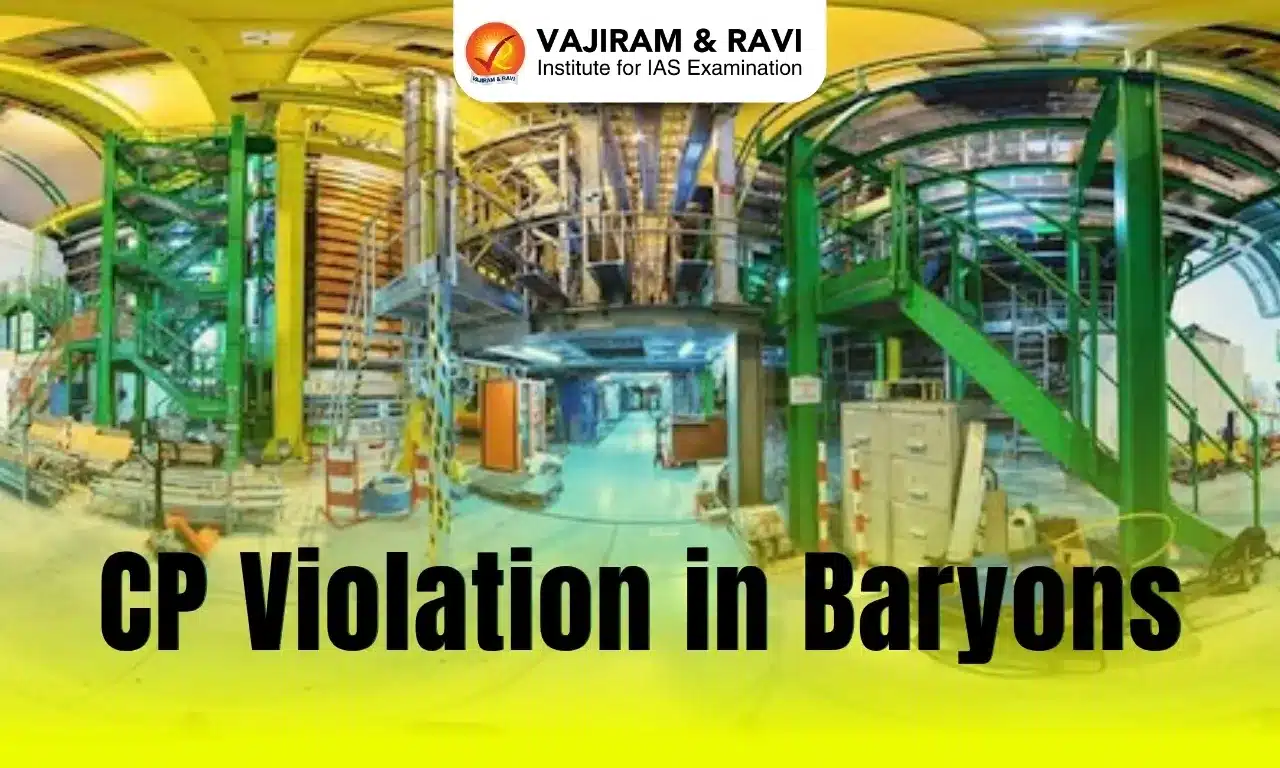CP Violation in Baryons Latest News
- Recently, European scientists observed, for the first time, that matter and antimatter versions of a subatomic particle called a baryon decay at different rates.
- This difference in behavior could help explain why the universe is predominantly made of matter, offering a crucial clue to the long-standing antimatter mystery.
Matter and Antimatter
- Matter is what makes up everything we see around us—people, planets, stars—composed of particles like protons, neutrons, and electrons.
- Antimatter is like matter’s mirror image: for every matter particle, there’s a corresponding antiparticle with the same mass but opposite charge.
- For example:
- The antiparticle of an electron (negative charge) is a positron (positive charge).
- The antiparticle of a proton is an antiproton, with negative charge.
- When a particle and its antiparticle meet, they annihilate, releasing energy.
Why the Universe Has More Matter Than Antimatter
- The Big Bang should have produced equal amounts of matter and antimatter, but today, the universe is overwhelmingly made of matter.
- This imbalance remains one of science’s greatest mysteries. A key to understanding it lies in a phenomenon called CP violation—where the universe treats matter and antimatter differently.
- CP stands for charge conjugation (swapping particles with their opposites) and parity (mirror flipping left and right).
- Charge conjugation involves replacing every particle in a system with its antiparticle.
- For example, an electron would be replaced with a positron, a proton with an antiproton, and so on.
- CP symmetry implies that physical laws should remain the same when a particle is replaced by its antiparticle and its spatial coordinates are inverted.
- CP stands for charge conjugation (swapping particles with their opposites) and parity (mirror flipping left and right).
- If both symmetries held perfectly, matter and antimatter would behave identically.
- However, experiments have shown that CP symmetry can be broken.
- This violation is essential to explaining how the early universe ended up with more matter than antimatter.
First Observation of CP Violation in Baryons
- Until now, CP violation had only been observed in mesons—particles made of a quark and an antiquark.
- For the first time, scientists have detected CP violation in baryons, which are three-quark particles like protons and neutrons that make up most visible matter.
- The breakthrough came from studying the decay of the Λb0 baryon.
- The Λb0 baryon is a subatomic particle known as a “bottom lambda baryon.”
- It’s a type of baryon, meaning it’s composed of three quarks, and it contains one up quark, one down quark, and one bottom quark.
- The “0” in Λb0 indicates that it is electrically neutral.
- This particle is also sometimes referred to as an “open-beauty baryon”.
- Researchers found that these two decayed differently into a proton, a kaon, and two pions, providing the first evidence of CP violation in baryon decays and offering new insight into the matter-antimatter imbalance in the universe.
How Scientists Observed CP Violation in Baryon Decay
- The discovery was made at Europe’s Large Hadron Collider (LHC) using the LHCb detector, which recorded data from billions of proton-proton collisions over several years.
- These collisions occasionally produced Λb0 baryons and their antiparticles (Λb0-bar).
- Scientists then compared how often each version decayed into those particles. A difference in decay rates, after correcting for experimental biases, indicated CP violation.
- To ensure accuracy, the team used a control channel—where no CP violation is expected—to filter out false signals and isolate the real effect.
Conclusion
- While the observed CP violation is not enough to fully explain the matter-antimatter imbalance, it opens new avenues for further study.
- Scientists will now explore other baryon decays and refine measurements to uncover deeper sources of CP violation—potentially revealing unknown forces or particles.
- This discovery takes us closer to answering one of the universe’s most profound questions: why does anything exist at all?
Last updated on January, 2026
→ Check out the latest UPSC Syllabus 2026 here.
→ Join Vajiram & Ravi’s Interview Guidance Programme for expert help to crack your final UPSC stage.
→ UPSC Mains Result 2025 is now out.
→ UPSC Notification 2026 is scheduled to be released on January 14, 2026.
→ UPSC Calendar 2026 is released on 15th May, 2025.
→ UPSC Prelims 2026 will be conducted on 24th May, 2026 & UPSC Mains 2026 will be conducted on 21st August 2026.
→ The UPSC Selection Process is of 3 stages-Prelims, Mains and Interview.
→ UPSC Result 2024 is released with latest UPSC Marksheet 2024. Check Now!
→ UPSC Toppers List 2024 is released now. Shakti Dubey is UPSC AIR 1 2024 Topper.
→ Also check Best IAS Coaching in Delhi
CP Violation in Baryons FAQs
Q1. What is antimatter?+
Q2. Why is the universe mostly matter?+
Q3. What is CP violation?+
Q4. Where was CP violation in baryons observed?+
Q5. Why is this discovery important?+
Tags: cp violation in baryons mains articles upsc current affairs upsc mains current affairs

















